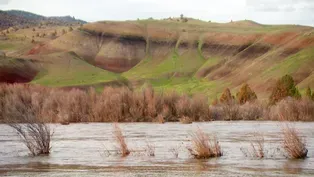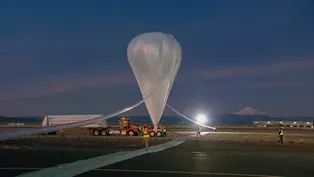Oregon Field Guide
Bonsai Mirai
Clip: Season 34 Episode 7 | 11m 24sVideo has Closed Captions
Ryan Neil captures the West's rugged landscape in bonsai form.
After a traditional apprenticeship in Japan, Oregon bonsai professional Ryan Neil is capturing the West's rugged landscape in bonsai form. We follow one tree over the course of a year, as well as venture into the wilderness with Ryan to see nature through his eyes.
Oregon Field Guide
Bonsai Mirai
Clip: Season 34 Episode 7 | 11m 24sVideo has Closed Captions
After a traditional apprenticeship in Japan, Oregon bonsai professional Ryan Neil is capturing the West's rugged landscape in bonsai form. We follow one tree over the course of a year, as well as venture into the wilderness with Ryan to see nature through his eyes.
How to Watch Oregon Field Guide
Oregon Field Guide is available to stream on pbs.org and the free PBS App, available on iPhone, Apple TV, Android TV, Android smartphones, Amazon Fire TV, Amazon Fire Tablet, Roku, Samsung Smart TV, and Vizio.
Providing Support for PBS.org
Learn Moreabout PBS online sponsorship(birds chirping) - Originally, bonsai started in China and migrated to Japan, and both hint at trying to have this relationship with nature and bring that natural environment closer to home.
(boots crunching) My name's Ryan Neil, and I'm a bonsai professional, which doesn't quite feel accurate but there's not a better word for what I do right now.
We are at Bonsai Mirai, which is a facility that I conceptualize during my apprenticeship in Japan as being an incubator for the evolution and exploration of bonsai as a communicative art form.
The goal is not to remove all old needles.
If that's what happens, it sends a pine straight down into the gutter.
This is last year... We teach people the technical horticultural and artistic concepts to do bonsai well.
We explore how far we can push the boundaries of aesthetics.
For a bougainvillea, with its characteristics being a vine... And we educate online hoping that with that greater accessibility we're able to touch those people with this medium.
(steps crunching) So this is a Rocky Mountain juniper.
It came from a very arid, very windy environment, and having recovered from the process of collection we're now giving it its first styling and interpretation of representing that greater environment in miniature.
So I like to start by cleaning.
This process helps me understand all of those little nuances and quirks that I need to know to responsibly change the position of the branching.
(table clanking) Bonsai from me started at a county fair in Glenwood Springs, Colorado.
I was 12 years old and I saw these bonsai trees.
I just thought, wow, you know, like I just...
When it hit, it was like immaculate conception, when it was just like, that's what I'm doing with my life.
Within a month of that experience, I was exposed to Masahiko Kimura's work whom I would eventually apprentice myself to for six years.
Masahiko Kimura is largely regarded as the father of modern bonsai, and just the innovative avant-garde way he approached the art form resonated with me.
I went to school for horticulture and I wrote Mr. Kimura a letter in Japanese and I didn't hear back.
And so I wrote him another letter and I didn't hear back.
I heard back from him 23 letters later, two years, that I could come to Japan.
This is probably where the front needs to be, because this is a very large piece of negative space over here.
With this branch dropping down into this space do something really magical for this tree.
Do I want to try and bend that branch?
Do I need to bend that?
Do I need that branch?
Do I even need that branch is a big question.
The chances of breakage are high to very high, but that is what it's gonna take.
Hmm.
Okay.
So I think that's what we're gonna do.
The traditional model is trying to find that optimal pyramid every coniferous tree wants to grow like that.
And then lightning strikes and gale-force winds hit, but the tree continues functioning to the best of its ability in that new circumstance, and suddenly that symmetry now becomes asymmetry.
And then lightning strikes again, and drought and insects, and that tree is pushed into a further degree of asymmetry.
And you start to see this incremental shift from young to old, and you just have a really good story there.
And you match the aesthetic to those characteristics.
(Ryan exhales) Good.
(exhales) And of course, I want a little bit more.
(Ryan panting) Okay.
I hear it.
I hear it starting to tear.
Can hear it right here.
It's just everything's stretching.
It's stopped now.
So you know now this tree recuperates from this design session and we will re-pot it next spring, and that will be sort of the beginning of its life as a bonsai.
My name's Ryan Neil.
I'm 24 years old.
I've been here for closing in on two years now, and I wish I could say it's getting easier, but it seems like things just keep getting more and more complicated as the depth of understanding in the art progresses.
My apprenticeship in Japan with Masahiko Kimura was very, very challenging.
The notion of apprenticeship on that kind of traditional level demands a lot of humility.
And so as an American who has my own thoughts and opinions, that nobody in that structure cares about, was a real big challenge to make that adjustment integrate.
And so just the sacrifice of the self was the ultimate challenge.
(Ryan speaks in Japanese) (Masahiko speaks in Japanese) - In the end, he told me, "When you go back to the United States for you to not change bonsai in North America would be a failure.
It would be a failure."
And that was it.
(birds chirping) When I came back from Japan... Let's go!
I was really inspired to understand continental North America a little bit better.
Come on.
Originally, when Bonsai started, the stunted tree out of the wild had a spirit and a soul that was difficult to create.
But there is definitely an ethic with collecting these stunted trees.
We're privileged to have national forest, and there are definitely places where you can and can't collect, but you gotta follow the rules.
Oh.
Oh, that's interesting.
That's super interesting.
Sub-alpine fir lost its top, and each of these little branches is popping up as a sub-trunk because the apex was lost.
It's just really interesting.
This tree has just an absolute quest to survive.
That's it.
It's a wonderful aesthetic.
You know, north America is such a dramatic landscape, but not everybody can come up here.
Not everybody knows that this does exist.
And it's like to use this vehicle of the miniaturized tree, you're trying to take people there.
This tree would have no possibility of being collected.
It's completely locked in the rock.
But it doesn't matter whether or not a tree is collectible.
When you see these things, it just adds to this file system of imagery of what you can pull on when you get to work on different species of trees.
It certainly is inspiring.
So this is the tree that we worked on last year, and now that it's grown and recovered, we have the opportunity to put it into its first bonsai container.
(tool stabbing) I am sculpting the root system so that it can stand on its own.
(Ryan blows) Okay.
It's really, it's an interesting time to be alive, because so much has been at our fingertips.
I sense that we're moving backwards, and maybe that's not such a bad thing, because that causes us to rethink the system.
That's one of the big issues with sustainability is it's such a big concept that it's almost impossible to digest.
And that's really where I've seen bonsai have a lot of power.
You know, it makes it digestible, because you just have to worry about your relationship with this singular tree.
And that becomes a metaphor that highlights our collaborative relationship with the natural environment.
So the whole thing ties together in the end.
Okay.
I have to prepare the container now.
That pairing of the tree to the containerized environment is the first time that it becomes a bonsai.
Once it's in that bonsai container, you are in a continual collaborative relationship in order for that tree to survive.
It's just a little too small but that's the marriage that allows us to control the energy system of the tree enough to keep it from being a big tree and really empower that stunted tree to have a bigger voice.
(Ryan exhales) Took that last little (whistles), just that (tongue clicks), little nudge, just that last little nudge.
I'm not Japanese.
There are things I'll never understand about Japanese culture, but I learned in Japan that you can't know something unless you've existed in it through good, bad, and ugly.
So from me, as we continue to evolve this art form in the Western world, I chose to embed myself in this wonderful landmass of North America.
These nuances of the land are what we're losing.
And through these little trees, I look at those bigger trees and I recognize that I do have a place in their lifecycle just in the manner in which I choose to consume resources, and how I handle all of the living things that I come into contact with.
I think that's really beautiful.
- [Person] Cool.
- It's a real scalable awareness that bonsai has created, and it's like, oh, through this work I can communicate this relationship that we have.
And that has become the greater mission.
(no audio) (no audio) - Great people just doing their thing in their own northwesty way.
We love bringing you stories like this.
Support what you love.
opb.org/video.
Video has Closed Captions
Photo Essay of Oregon’s Painted Hills, by photographer Brandon Swanson. (1m 46s)
Video has Closed Captions
An Oregon ‘space balloon’ could reveal the secrets to successful Mars landings. (10m 19s)
Providing Support for PBS.org
Learn Moreabout PBS online sponsorship












